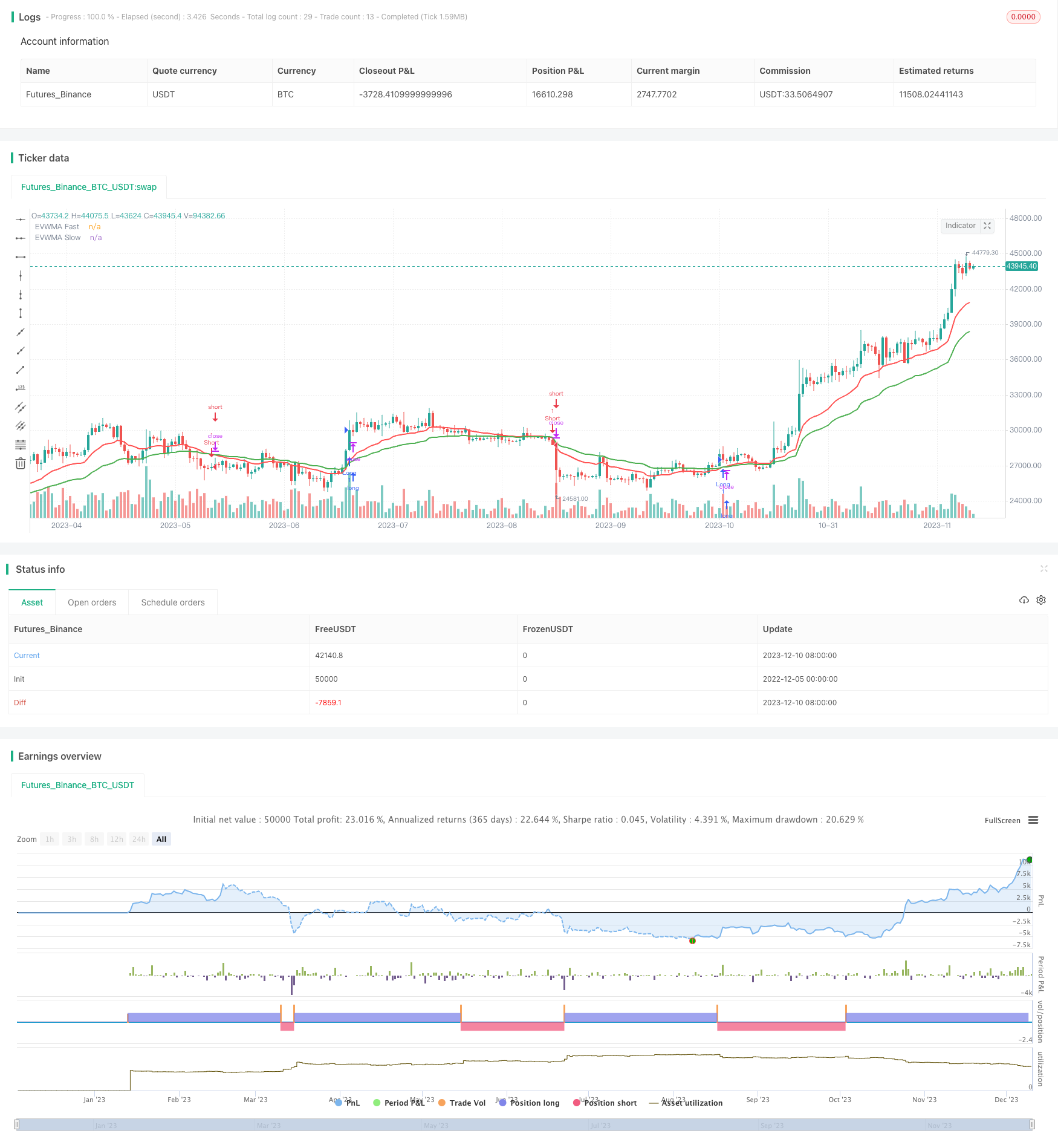
概述
本策略基于EVWMA指标设计了一个简单的趋势跟踪策略。该策略使用快速线和慢速线构建EVWMA指标,在快线上穿慢线时做多,在快线下穿慢线时做空,实现趋势跟踪。
策略原理
该策略的核心指标是EVWMA,即弹性量加权移动平均线。它通过自身计算周期长度的方式,结合价格和交易量的信息,动态地反映市场趋势。
具体来说,快速线的计算周期长度为最近10根K线的成交量之和,慢速线计算周期长度为最近20根K线成交量之和。每根K线的EVWMA按照“(前一日EVWMA × (周期长度-当前K线volume) + 当前K线收盘价 × 当前K线volume) / 周期长度”的公式计算。这样就同时结合了价格和交易量信息。
当快速线上穿慢速线时,表示买入力量增强,做多;当快速线下穿慢速线时,表示卖出力量增强,做空。通过这样的快慢线组合,可以动态地捕捉市场趋势,实现趋势跟踪策略。
优势分析
本策略最大的优势在于利用EVWMA指标的动态周期设计,可以更快地响应价格和交易量的变化,实时捕捉市场趋势,这对于趋势跟踪策略非常适合。此外,相比传统移动平均线等指标,它结合了价格和交易量信息,可以过滤假突破。
风险及解决方法
该策略的主要风险在于EVWMA指标参数设置的问题。如果快线和慢线周期设定不当,可能导致产生大量假信号。此外,趋势跟踪策略本身 justes trendyțile consecințe în cazul inversării bruște a tendinței pieței.
为了解决这些问题,可以通过优化参数,调整快线和慢线的计算周期,找到最佳参数组合。同时,可以设置止损来控制亏损风险。在市场可能发生重大转折的时间点,例如重要数据发布,可以考虑暂停策略,避开这个时间段。
优化方向
该策略还具有进一步优化的空间。例如,可以考虑加入其他指标,如交易量的突破、布林带等来确认信号,从而提高策略的稳定性。此外,不同品种和不同时间段参数组合的最优值可能会有所不同,可以建立参数自适应优化机制,根据实时数据调整参数。
从交易面来看,还可以设计动态止损、跟踪止损等方法来控制风险。此外,不同品种和不同时间段参数组合的最优值可能会有所不同,可以建立参数自适应优化机制,根据实时数据调整参数。
总结
本策略利用EVWMA指标的动态周期设计和对交易量信息的考量,构建了一个简单有效的趋势跟踪策略。它可以快速响应价格变化,捕捉市场趋势。通过参数优化、风险控制等手段,可以进一步提升策略稳定性。该策略思路新颖,值得进一步探索与应用。
/*backtest
start: 2022-12-05 00:00:00
end: 2023-12-11 00:00:00
period: 1d
basePeriod: 1h
exchanges: [{"eid":"Futures_Binance","currency":"BTC_USDT"}]
*/
//@version=4
strategy("QuantNomad - EVWMA Cross Strategy", shorttitle="EVWMA Cross", overlay=true)
// Inputs
fast_sum_length = input(10, title = "Fast Sum Length", type = input.integer)
slow_sum_length = input(20, title = "Slow Sum Length", type = input.integer)
// Calculate Volume Period
fast_vol_period = sum(volume, fast_sum_length)
slow_vol_period = sum(volume, slow_sum_length)
// Calculate EVWMA
fast_evwma = 0.0
fast_evwma := ((fast_vol_period - volume) * nz(fast_evwma[1], close) + volume * close) / (fast_vol_period)
// Calculate EVWMA
slow_evwma = 0.0
slow_evwma := ((slow_vol_period - volume) * nz(slow_evwma[1], close) + volume * close) / (slow_vol_period)
// Plot
plot(fast_evwma, title = "EVWMA Fast", linewidth = 2, color = color.red)
plot(slow_evwma, title = "EVWMA Slow", linewidth = 2, color = color.green)
// Strategy
strategy.entry("Long", true, when = crossover(fast_evwma, slow_evwma))
strategy.entry("Short", false, when = crossunder(fast_evwma, slow_evwma))